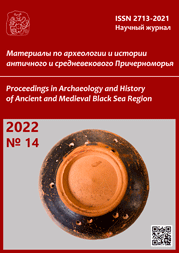«Савроматское» захоронение с У-образными псалиями в верховьях р. Эмба
A “Sauromatian” burial with У-shaped cheek-pieces discovered on the upper Emba river
Author(s): Aslan Mammadov, Petr I. ShulgaSubject(s): Archaeology, Ancient World
Published by: Нижневартовский государственный университет
Keywords: Prokhorov culture; Early nomads; Southern Urals; Horse equipment; Bridle; У-shaped cheekpieces; bits;
Summary/Abstract: In 2021, a chief grave (No. 3) was recovered in the burial mound No. 1 at the barrow field of Zhagabulak I by archaeologists of the A.Kh. Margulan’s Institute of Archaeology and by those of Aktobe Regional Museum of Local History. The Zhagabulak barrows are located within the frontier area at junction of the South Cis-Urals, the Ustyurt Plateau, and the Aral Sea Region. Until now, the research area was only explored on the limited basis. It is this particular spatial location which imparted an intermediate and transitional character to the materials discovered in the barrow No. 1. The artifacts found there seem to reflect peculiarities borrowed both from nearby lands and distant territories east and west of them. In this regard, the iron bridle set from the burial No. 3 is of special interest. It contains У-shaped cheek-pieces of a type corresponding to those bronze У-shaped cheek-pieces that were used in the Early Scythian times from the 7th until the early 6th c. BCE within a restricted area in the Altai and Tuva. The Zhagabulak horse bit bars have loop-shaped ends similar to those the western Scythian horse bits normally have had. On the other hand, loop-shaped horse bit bars have never been reported to occur from the contexts dated back to the 6th until the 3rd c. BCE in the Altai, in South Siberia, in Xinjiang, or elsewhere in the East. In addition to this, the mouthpiece and cheek-pieces from the burial No. 3 represent an all-in-one horse bit device of a type which was widely spread throughout Western Asia and has already been evidenced in the Aral Sea Region in the Early Scythian times. The У-shaped cheek-pieces discovered in the burial No. 3 could hardly be interpreted as reutilized bridle parts of the Early Scythian horse harness. In the area under study, cheek-pieces of this type have already been developed to be utilized with western horse bits as late as the mid-6th c. BCE. The invention was based on У-shaped cheek-piece type of eastern origin still useable in that time. The Zhagabulak horse bridle with У-shaped cheek-pieces may as well suggest an earlier date – roughly around the mid-6th c. BCE — for the quiverfuls of arrows, similar to those found in the burial No. 3.
Journal: Материалы по археологии и истории античного и средневекового Причерноморья
- Issue Year: 2022
- Issue No: 14
- Page Range: 11-40
- Page Count: 30
- Language: Russian

